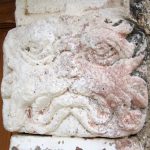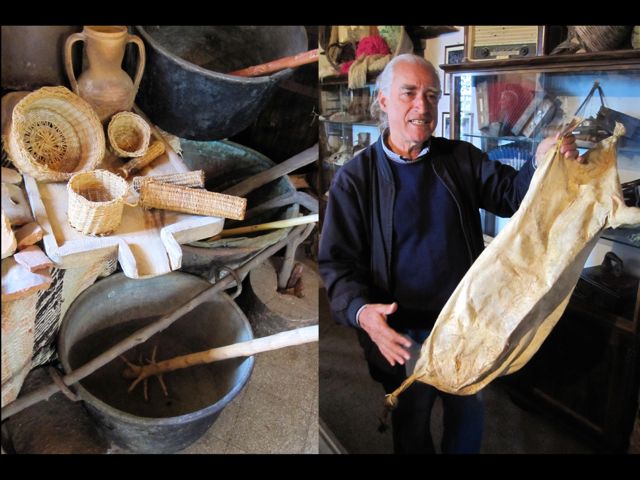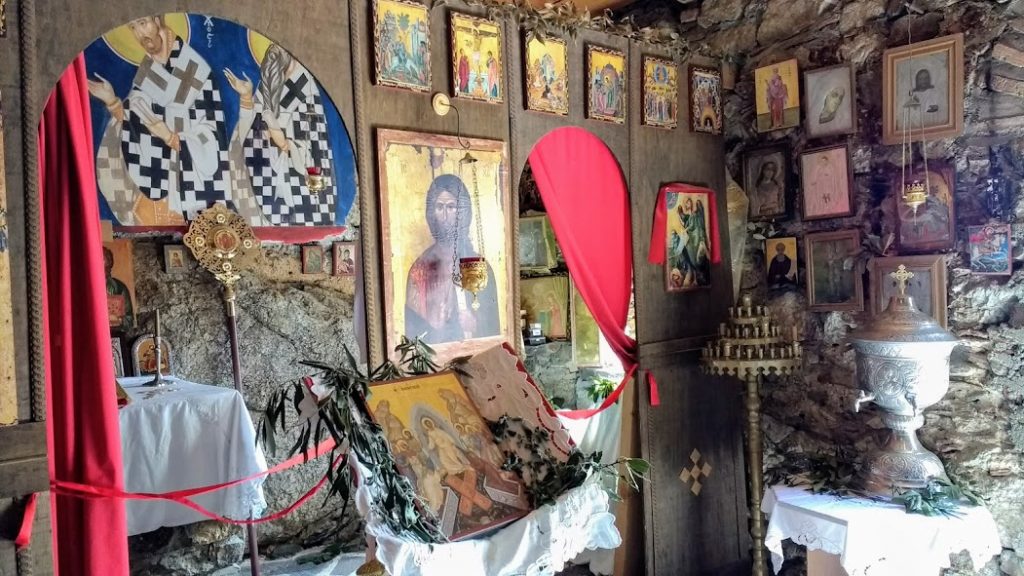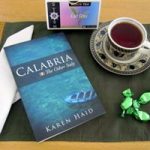“Kalimera.” A spry, older woman dressed in black warmly greeted us as we stepped out of the car and began to walk up the street to the main square of Gallicianò. She was like the town sentinel and greeter all in one, speaking perfect Italian to us, then lithely pulling a cell phone out of her pocket to call our guide in a language I didn’t understand at all.
Calòs ìrtete Gaddihicianò – WELCOME TO GALLICIANÒ
I was visiting a village at the very tip of Italy, on the edge of the Aspromonte Mountains in southern Calabria, the last bastion of Greek civilization in the region. Just forty people remain in Gallicianò, which today is officially a district of the larger community known as Condofuri. They speak grecanico (Grecanic), a language that hearkens back to ancient Greece, to Magna Graecia of southern Italy, founded in the eighth century BC.
The drive up to the village, past banks of prickly pear cactus and the occasional goatherd, revealed the area’s remoteness. What were those early Greek settlers thinking? The road flanked a wide, gray, dry riverbed, the fiumara Amendolea, and climbed up wild, rugged hills that extended further inland. The town site afforded an expansive panorama of the entire area all the way out to the Ionian Sea – a natural lookout and defense, seemingly impossible to reach. In ancient times, however, the dry, rocky wash was a navigable river. Today’s vehicles, albeit few, zigzag relatively easily up to Gallicianò.

View from Gallicianò
WHAT’S IN A NAME?
As I began to form my first impressions of the village, we were told Mimmo L’Artista would arrive shortly for our tour. Musing as to what type of artist this Mimmo was, I started taking pictures of the old stone buildings as well as a few Greek flags and the numerous street signs written in the Grecanic language.

Gallicianò Street Sign in Grecanico and Greek
Before I knew it, Mimmo breezed into the square with a big smile and an even bigger enthusiasm for his culture. His name was Domenico Nucera, which may not sound all that common to an English speaker, but in Gallicianò he shares his last name with each and every other inhabitant. They manage to keep it all straight with the use of nicknames, which are inherited within families. So you just hope that your grandfather didn’t have an occupation, a personality trait or other distinguishing feature that would prove embarrassing a few generations down the line.
Mimmo told us that he was christened artista when he was on a town committee in which every member’s name was Domenico Nucera. Mimmo is short for Domenico, but with five or six Mimmos, confusion will inevitably arise; thus, the personal soprannome or nickname. His fate was decided based on the fact that he went to a high school for the arts.

Nucera – a sack with the most popular last name in Gallicianò
TOUR OF GALLICIANÒ

Gallicianò, Church of St. John the Baptist in the distance
Our visit that morning ranged from the ethnographic museum to the sorgente dell’amore (fountain of love), and from the rather spartan Church of St. John the Baptist to the richly decorated Orthodox Church, The Madonna of Greece. We saw where pigs were slaughtered, knives sharpened and the communal area where women traditionally washed their clothes. We were accompanied by the gentle sound of sheep bells as the animals passed through the surrounding hills and by goats, agilely running around us and up the rocky embankments.

Goat in Gallicianò

Apotropaic architectural element
I wouldn’t have thought we could have spent three hours visiting such a small town, but the time went by quickly listening to Mimmo L’Artista’s enthusiastic explanations of his village’s traditions. We saw old stone architectural elements to ward off the evil eye and street signs in Grecanic and Greek.
Before we knew it, our stomachs told us it was time for lunch and a woman beckoned us into a small stone building filled with the lovely aroma of freshly baked sourdough bread. A good number of loaves sat on a table covered with a simple cotton cloth. The structure’s single room had a large hearth and an old wooden floor. Various vegetables preserved in olive oil were ready to make a flavorful sandwich together with the local cheese. Delicious.

Bread in Gallicianò
ETHNOGRAPHIC MUSEUM IN GALLICIANÒ

Gallicianò Ethnographic Museum
The town has a small museum in what was once an elementary school. Objects representing crafts and everyday life are on display, such as those that highlight the practice of creating cloth from Scotch broom, the hearty plant with bright yellow flowers that light up the hillsides of the area during spring. Our guide took us through the process of turning the fibrous plant into a workable thread that produced articles ranging from those with rougher material destined for work purposes to refined bedspreads.

Gallicianò Ethnographic Museum, cheese-making objects and Mimmo L’Artista talking about the zampogna (bagpipe)
Musical instruments, tools for fieldwork, items used in making cheese, baskets, shoes, soap and objects with traditional Greek patterns are amongst those on display. There is also an area that depicts a typical living space to give a feel for the old village life.

Handcrafted wood objects at the Gallicianò Ethnographic Museum
Simple daily chores, such as going to the fountain with an earthenware jug for water or washing clothes at the outdoor, communal laundry area were focal points of social interaction. The main water source is still called the Fountain of Love and recalls the place young men and women would meet with the pretext of getting a drink of water or filling a jar for use at home.

Author Karen Haid with a small water jug in Gallicianò
ORTHODOX CHURCH OF GALLICIANÒ

Orthodox Church, The Madonna of Greece, Gallicianò
While the Church of St. John the Baptist anchors the community both architecturally and religiously, for the visitor, the jewel in the crown of Gallicianò is the smaller Orthodox Church, a short walk up the hill to the other side of town. Dedicated to the Madonna of Greece, this attractive, tile-roofed structure in Byzantine style welcomes pilgrims with colorful stonework outside and a vibrant interior full of icons. We each rang the bell at the entranceway, three times as instructed, to keep with the tradition.

Orthodox Church, The Madonna of Greece
Although the citizenry as a whole follow the Roman Catholic rite, the Orthodox Church serves as an important connection with not only the town’s Greek heritage, but also with the memory of the many Greek and Byzantine churches that once flourished throughout Calabria.

Church window
KEEPING THE TRADITION ALIVE IN GALLICIANÒ
Today, only forty people live in Gallicianò and actively communicate in the Grecanic language. They are very happy to welcome visitors to their village, and are pleased to share their culture with them. However, there is a tinge of melancholy, perhaps best summed up by the greeting on the stone sign located at the entrance to the town: Welcome to Gallicianò, here in the mountains full of pain and songs.

Welcome to Gallicianò

Gallicianò pinned on map
Visit Gallicianò on the CASTLES AND WINES OF CALABRIA TOUR!
Would you like to hear the Grecanic language spoken in Gallicianò? Listen to Mimmo L’Artista welcoming visitors in Calabrian Greek.
Read more about other towns with Greek heritage on this blog, such as Pentedattilo: A Ghost Town in Calabria, The Castle of Amendolea and Palizzi: Yesterday and Today. And for an in-depth look at the beautiful land in the toe of the boot, check out Calabria: The Other Italy, my non-fiction book about daily life, history, culture, art, food and society in this fascinating southern Italian region.
 “Like” Calabria: The Other Italy’s Facebook page and follow me on Karen’s Instagram and Karen’s Twitter for more beautiful pictures and information.
“Like” Calabria: The Other Italy’s Facebook page and follow me on Karen’s Instagram and Karen’s Twitter for more beautiful pictures and information.
Sign up below to receive the next blog post directly to your email.

Comments 18
Very interesting…but why are there only 40 people? Is it that it’s just too remote for people to choose to live there at this point? The old stone structures are very beautiful. Are the 40 people there just to maintain these buildings?
Author
Towns and villages tend to get smaller as there isn’t work. Young people don’t stay and many emigrate to northern Italy or foreign countries. It’s a problem all over the country.
Can you give me a better idea where this is? We were just back in Italy/Calabria visiting family and house hunting.
And yes, the poverty and lack of work in Calabria is a big problem.
Author
I put a little map at the end of the post. It isn’t that clear, but you can see Gallicianò pinned in red at the very south of Calabria.
My name Is Dino Papas from Athens Greece
I very proud of you that you holding Greek inheritance for so many years
God bless you
Dino Papas
Palm beach Gardens Fl US
Author
Thank you, Dino, and all the best to you in Florida.
So interesting, and these people wanting to hold their Greeknes after so many years…. amazing
Author
It’s their heritage, and as you say, the spirit of these villagers who want to preserve their language and history is uplifting.
Yes i agree. Hope to see one day.
VERY INTERESTING STORY & PHOTOS!!! A good one of you & YOUR water jug! Hope you also brought some water up from the sorgenti dell’amore!! 😉
Author
Ha, ha! Thanks. I must say that I’m fascinated by the women who carried (and balanced) such weights on their heads.
Very interesting, and such a beautiful paese! There is one near my paese called Greci, where the 750 inhabitants (a veritable metropolis compred to 40) speak a Greek like dialetto. I tried looking it up and instead I found out there are 9 towns in Provincia di Lecce that together are called ‘Greci Salentino’ and they speak a Greek dialetto. Then I realized the reason I couldn’t find my Greci is because it isn’t in Puglia, it’s in Campania. When I go for my morning passeggiata, in Puglia, I enter the periphery of Greci, but it is too far to walk there. The residents of Greci are actually originally from Albania! Now i’ll have to pay the town a visit next time my Zio goes to buy caciocavallo. Ciao, Cristina
Author
My understanding is that the language spoken in Puglia is called Griko and there are many more speakers of it than in Calabria, where the term is often Grecanico or Calabrian Greek. There are a number of pockets of people with Albanian heritage in South Italy, and the word for their language, which differs from one area to the other, is Arbëreshë. It’s amazing the number of languages spoken in the Italian boot! You’ll definitely have to check it out and pick up some caciocavallo for yourself.
Thank you for showing me another interesting destination to visit – too many in Calabria!
Author
That’s for sure – glad you liked it.
I think that these efforts to show the connections between Greeks & Southern Italians are good. My family history is from Zakynthian where my Parents are from. The Ionian Islands have an historic affiliation with Italians having been ruled by Venetians for several 100 years.
What a captivating glimpse into Gallicianò! It’s a compelling reminder of the unique stories that small villages like this hold. The sense of community and the pride in their heritage are palpable, making me want to visit and immerse myself in their traditions. Such a hidden treasure.
Author
Absolutely, beautifully said.